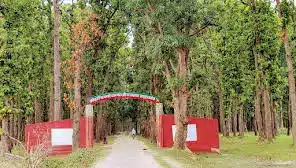About Sohagibarwa Wildlife Sanctuary:
- It is located in the Maharajganj district of Uttar Pradesh.
- It was declared as a Wildlife Sanctuary in June 1987.
- Borders: On the northern side, it shares the international boundary with Nepal, and on the eastern border is Bihar’s Valmiki Tiger Reserve.
- Vegetation: The vegetation of this area is of North Indian Moist Deciduous type.
- Rivers: It is drained by the great Gandak, the little Gandak, Pyas and Rohin rivers.
Topography:
o It is almost flat with an average height of 100mtrs above mean sea level.
o The area gently slopes from North–West to South–East.
o The area of the Sanctuary is a vast alluvial plain. The underlying soil of the area consists of alluvial formation, showing a succession of beds of clay, silt and sands.
Flora:
o Nearly 75% of the area consists of Sal forest, and other humid areas are covered with Jaamun, Gutal, Semal, KhairTrees, etc.
o Lower region of the sanctuary, which is water logged during rains, consists of Grasslands and patches of Cane forests.
Fauna:
o It is inhabited by a variety of animals which mainly includes Leopard, Tiger, Jungle Cat, Small Indian Civet, Langur, etc.
o The Avifauna is varied with Little Cormorant, Snake Bird, Brahimini Duck, Common Teal, Little Egret, Cattle Egret, Paddy Bird etc.
Q1) What is deciduous forest?
A deciduous forest is a type of biome characterized by the prevalence of deciduous trees, which are trees that shed their leaves seasonally. These forests can be found in temperate regions around the world, including parts of North America, Europe, and Asia
Source:Yogi calls for archaeological excavation in Sohagibarwa Wildlife Sanctuary
Last updated on June, 2025
→ UPSC Notification 2025 was released on 22nd January 2025.
→ UPSC Prelims Result 2025 is out now for the CSE held on 25 May 2025.
→ UPSC Prelims Question Paper 2025 and Unofficial Prelims Answer Key 2025 are available now.
→ UPSC Calendar 2026 is released on 15th May, 2025.
→ The UPSC Vacancy 2025 were released 1129, out of which 979 were for UPSC CSE and remaining 150 are for UPSC IFoS.
→ UPSC Mains 2025 will be conducted on 22nd August 2025.
→ UPSC Prelims 2026 will be conducted on 24th May, 2026 & UPSC Mains 2026 will be conducted on 21st August 2026.
→ The UPSC Selection Process is of 3 stages-Prelims, Mains and Interview.
→ UPSC Result 2024 is released with latest UPSC Marksheet 2024. Check Now!
→ UPSC Toppers List 2024 is released now. Shakti Dubey is UPSC AIR 1 2024 Topper.
→ Also check Best IAS Coaching in Delhi






















